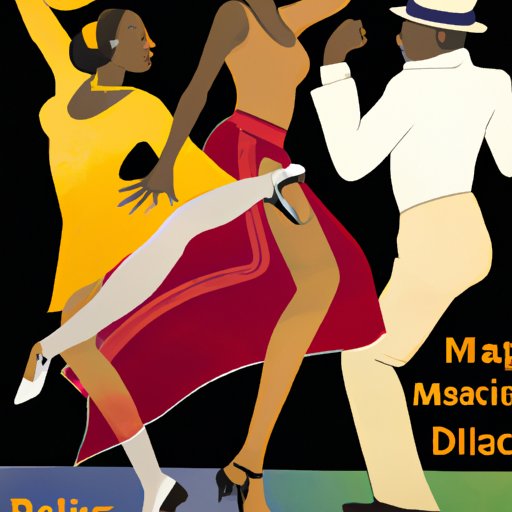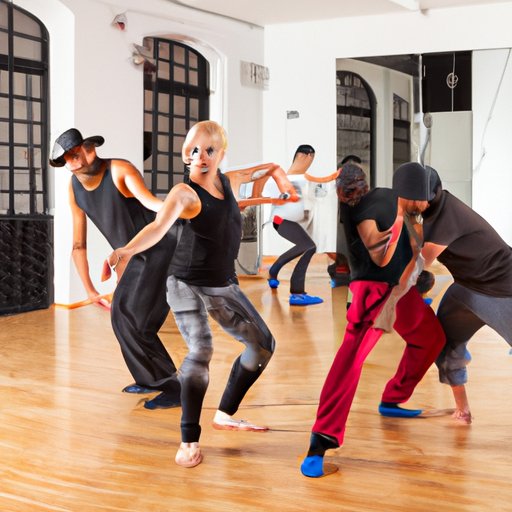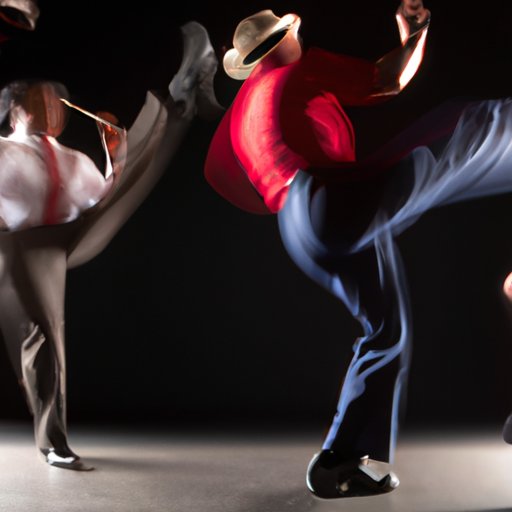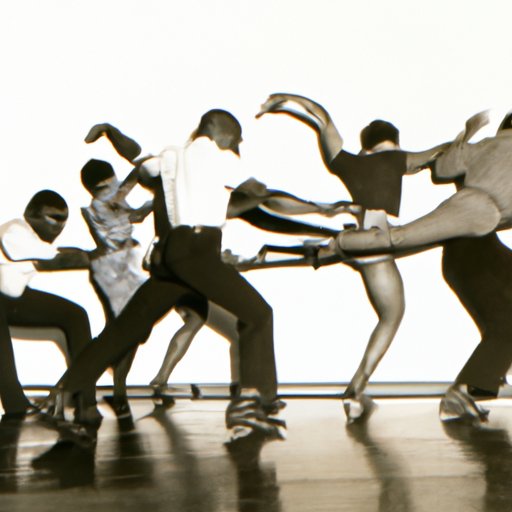Introduction
Jazz dance is a form of dance that is often characterized by its energy, enthusiasm, and improvisation. It incorporates elements from various other dance styles, such as African and European, and has been influenced by American culture and music. In this article, we will explore the cultural origins and evolution of jazz dance, including its African and European influences, how it has been shaped by social movements, and the pioneers who helped shape its development.

A Historical Overview of the Origins of Jazz Dance
The origins of jazz dance can be traced back to Africa and Europe. African dances such as the ring shout, juba, and hambone were brought to America by slaves, and these dances served as the foundation for early jazz dance styles. European dances such as the polka, waltz, and schottische also had an influence on early jazz dance. These dances were adapted and combined with African rhythms and movements to create something new and unique.
The impact of American music and culture was also significant in the development of jazz dance. Jazz music, which originated in New Orleans in the early 1900s, was at the forefront of the jazz dance movement. This new genre of music was heavily influenced by the blues and ragtime and was characterized by its syncopated rhythms and improvisational style. As jazz music grew in popularity, dancers began to incorporate its unique rhythms and movements into their dancing.
Examining the Cultural Influences on Jazz Dance
Societal expectations have played an important role in shaping the development of jazz dance. During the 1920s and 1930s, jazz dance was heavily associated with nightclubs and bars, where it was seen as a way to express oneself and let go of inhibitions. As the decades passed, jazz dance became more accessible to the general public, and it developed into a more artistic form of expression.
Social movements have also had a major impact on the evolution of jazz dance. During the Harlem Renaissance, jazz dance was used as a way to celebrate African-American culture and identity. The Women’s Rights Movement saw the emergence of female jazz dancers who pushed the boundaries of what was considered “acceptable” for women. The Civil Rights Movement further propelled the development of jazz dance, as it provided a platform for dancers to express their political beliefs and fight for equality.
Technology has also had an influence on the evolution of jazz dance. With the advent of television and film, jazz dance was able to reach a much wider audience, allowing it to become more popular and accepted. Additionally, new technology such as computerized lighting, sound systems, and video recording equipment has allowed dancers to push the boundaries of their craft and create more intricate and exciting performances.
Exploring the Pioneers of Jazz Dance
Katherine Dunham was one of the most influential figures in the development of jazz dance. A dancer, choreographer, and anthropologist, Dunham was dedicated to preserving and celebrating African-American culture through her work. She developed her own style of jazz dance, which blended elements of African, Caribbean, and modern dance. Her choreography was revolutionary and inspired generations of dancers to come.
Bob Fosse is another key figure in the history of jazz dance. His innovative choreography combined elements of burlesque, vaudeville, and classical ballet to create a unique style of jazz dance. His iconic choreography was featured in musicals such as Chicago and Sweet Charity, and his influence can still be seen in contemporary jazz dance today.
Jack Cole is also credited with helping to shape the development of jazz dance. An actor, dancer, and choreographer, Cole was known for his theatrical and highly energetic choreography. He incorporated elements of ballet, modern dance, and mime into his work, and his choreography was often seen as groundbreaking and ahead of its time.

Uncovering the Impact of Social Movements on Jazz Dance
The Harlem Renaissance was a pivotal moment in the history of jazz dance. This period saw the emergence of jazz clubs and the flourishing of African-American art, music, and culture. Dancers such as Bill Robinson and Josephine Baker used jazz dance to celebrate their culture and identity, and they helped to popularize jazz dance throughout the country.
The Women’s Rights Movement also had an impact on jazz dance. Female dancers such as Ann Miller and Gwen Verdon pushed the boundaries of what was considered “acceptable” for women, and they challenged traditional gender roles by performing daring and provocative choreography. Their influence can still be seen in contemporary jazz dance today.
The Civil Rights Movement further propelled the development of jazz dance. Dancers such as Alvin Ailey used their art to make powerful statements about race and social justice. Through their choreography, they were able to communicate their struggles and aspirations, and their work continues to inspire generations of jazz dancers today.
Analyzing the Elements of Jazz Dance
Jazz dance is composed of three main elements: music, choreography, and costuming. Music is essential to jazz dance, as it provides the rhythm and movement for the choreography. Jazz music is usually characterized by its syncopated rhythms and improvisational style, and it is often used to create a feeling of energy and excitement.
Choreography is the second element of jazz dance. Choreographers use a variety of techniques, such as isolations, syncopation, and body rolls, to create dynamic and engaging routines. Costuming is also important, as it helps to convey the mood and theme of the piece. Costumes can range from sleek and glamorous to funky and eclectic, depending on the style of the routine.

Investigating How Jazz Dance Has Evolved Over Time
The birth of modern jazz dance occurred during the 1940s and 1950s. This era saw the emergence of jazz dance companies, such as the Katherine Dunham Dance Company and the Alvin Ailey American Dance Theater, which helped to popularize jazz dance and spread its influence around the world.
Contemporary jazz dance is the most recent evolution of jazz dance. It is characterized by its fusion of elements from different dance styles, such as ballet, modern, and hip hop. Contemporary jazz dance is often seen as more expressive and dynamic than traditional jazz dance, and it has become increasingly popular over the last few decades.
Street jazz dance is a newer style of jazz dance that has emerged in recent years. It combines elements of hip hop, street dance, and funk to create an urban aesthetic. Street jazz dance is often seen as a more accessible form of dance, and it has gained popularity among young people.
Conclusion
Jazz dance has a rich and complex history that is deeply rooted in African and European cultures. It has been shaped by societal expectations, social movements, and technology, and it has been influenced by some of the most iconic dancers and choreographers of all time. Jazz dance continues to evolve and adapt to changing times, and its influence can be seen in many popular dance styles today.
In conclusion, jazz dance is an ever-evolving art form that has been shaped by many cultural influences. Its unique blend of music, choreography, and costuming has made it a beloved style of dance around the world, and its influence will continue to be felt for generations to come.
(Note: Is this article not meeting your expectations? Do you have knowledge or insights to share? Unlock new opportunities and expand your reach by joining our authors team. Click Registration to join us and share your expertise with our readers.)
